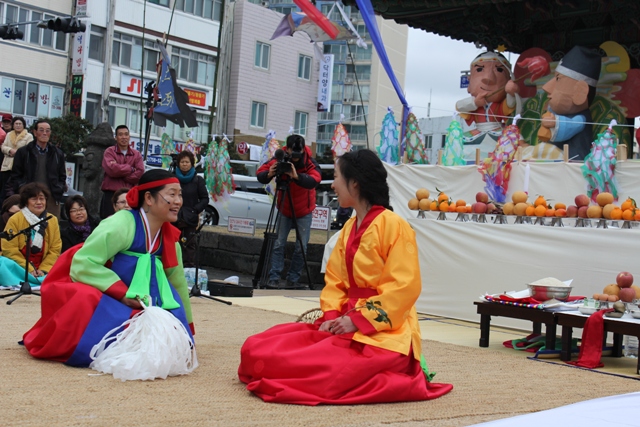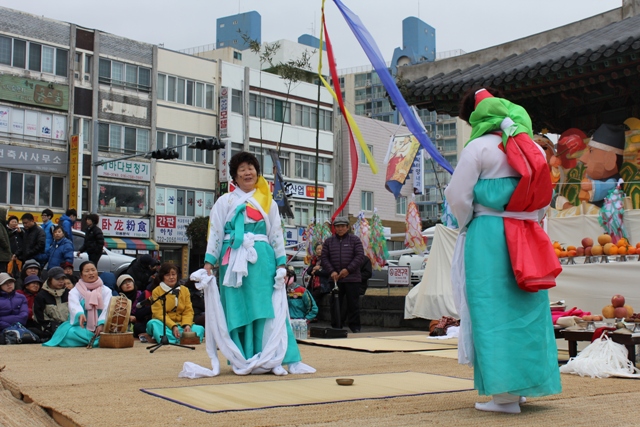 |
||
| Shaman Suh greeting the goddess Jacheongbi. Photo by Hong Sunyoung | ||
A large ‘keun-dae’ or wooden pole was erected on the pavillion of Gwandeokjeong, Jeju's oldest building (1448) which once served both government and military. The bridge that connects earth to heavens, it is believed that gods descend into the human world through the keun-dae.
Beneath this pole, 20 members of Jeju Keun-gut Preservation Society, led by shaman Suh Sun Sil, prepared the altar and welcomed the gods.
Ipchun-gut is the shamanist ritual in which people entreat the gods' beneficence for well-being and prosperity in the coming year. It has been held at the Gwandeokjeong site for the past 14 years.
It was once believed that only the best shaman on the island could perform the Ipchun-gut. According to shaman Kim Yoon Su, many shamans on the island would gather and compete to see who was the best, or 'dohwangsoo'.
Once selected, the dohwangsoo and other shamans would perform the 'gut' in front of an audience which included the magistrate, who celebrated Ipchun with his people by offering them food and drink.
Shamanist rituals include several sections: to invite the gods to the ritual site, to invoke their blessing, to entertain in order to please them, and to send them back to their world.
Accordingly, this year's Ipchun-gut consisted of chogamje, bonhyangdeum and divination.
Chogamje began with Shaman Suh's narration of the Cheonjiwang Bonpuri, Jeju's myth for the origin of the universe.
"In the beginning, the world was filled with darkness and confusion. Heaven and earth were one form without any separation....At the time of the creation of heaven and earth, a gap occurred in the dark form of the cosmos. The King of Heaven [Cheonjiwang] created a world with two sons and two moons, which was chaotic...."
Subsequent myths tell of the emperor's two sons, Daebyeolwang and Sobyeolwang, who created order out of chaos.
Through the ritual of Saedorim, the ritual space was purified and the lead shaman became a storyteller of the agriculture goddess, Jacheongbi. The Jacheongbi myth, based on the Sekyeong Bonpuri, encompasses a love story between the goddess and a godly youth named Mundoryeong, and includes her many ordeals such as crossing a sharp knife bridge [Kalseon-dori]. Jacheongbi, who bore a series of such hardships and became a goddess, depicts the character of the resilient Jeju woman.
 |
||
| Two shamans during Aeginollim-gut. Photo by Hong Sunyoung | ||
At the bonhyangdeum stage, Jacheongbi was enshrined, after which Shaman Suh sang the Seoujet-sori during which the attendant shamans danced, inviting devotees and audience members to participate.
There were two shamanist plays, or nori-gut. In the Aeginollim-gut, two assisting shamans reenacted infant care and asked the gods for babies' health and safety. This was followed by the Sekyeong-nori, a shamanist drama which first featured the pregnancy and delivery of a woman who escaped from her mother-in-law's persecution, followed by the depiction of field labor for an abundant harvest, together displaying the humor and satire of human life.
Ritual is often considered to have a rigid form. However, with dramatic elements such as the Aeginollim-gut and Sekyeong-nori, Jeju ritual offers comedy, tragedy, humor and satire to both devotees and audience.
Jeju shamanist gut provides a setting of non-ordinary time and space in which to meet the deities, but is rarely separated from the mundane.
Ipchun-gut ended with divination, for which shamans plucked threads from fabric and told fortunes according to whether the threads were neat or messy. When it was neat, which means good luck, devotees could bring the fabric home and keep it throughout the year.
At Ipchun-gut, where living myths were orally and ritually acted out, devotees participated in mythological realms. As per American mythologist Joseph Campbell, the mythical identification of Jeju people, in the ritual's expansion of time from linear to cosmic through which deities can engage in human affairs, was renewed.
There the universe, gods and humans were as one.
–
Dr. Hong is a scholar of cultural heritage and its intersection with tourism; she is a Jeju native. Dr. Hilty is a cultural health psychologist from New York who now makes Jeju Island her home; she has been studying shamanism around the world for more than 25 years.
Sunyoung Hong and Anne Hilty eastwest.psyche@gmail.com






